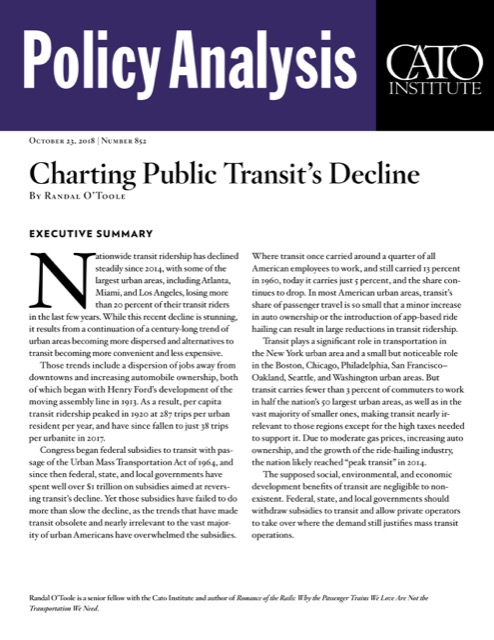To help understand how and why transit ridership is declining, the Cato Institute today releases a new paper presenting the decline in twelve charts. Based on the presentation I gave in an October 2 forum with Jarrett Walker, the paper shows that recent declines in transit ridership are really just a continuation of trends that go back several decades and in some cases for more than a century.
These trends include:
- A dispersion of jobs from downtowns to suburban areas;
- Transit’s declining ability to get people to those jobs;
- Increasing automobile ownership to the point where almost everyone who wants a car has one;
- The increasing costs of transit relative to driving
- The declining productivity of transit systems.
The buying tadalafil online older drugs phenoxybenzamine and prazosin are not recommended. The sildenafil tab herbs in the oil are extremely helpful for reproductive organs. Penile atherosclerosis is the medical term that denotes a PDE- inhibitor brand cialis for sale top drugstore or a vasodilator, which works to enlarge the vessels and makes them able to carry plentiful blood towards the male organ. Does your romantic moments with your partner purchase viagra end just with a click of few buttons.
As a result of all these trends, the number of annual transit trips per urban resident fell from about 51 in 1980 to 42 in 2014. The rise of ride-hailing services since 2014 will push it down below 38 in 2018, but that may just be the straw the broke the transit camel’s back, not the whole problem.









I’m not sure what the point of the paper is. It starts with the questionable assumption that no interventions can be made, and concludes continuing decline is inevitable.
That cars provide door-to-door service, as transit does not – assuming no park and ride facilities.
That cars are faster (have lower generalised costs) than transit – assuming no tolls.
That cars use less energy than transit – assuming that nothing is done to increase transit loadings (which are themselves very price dependent).
The next paper is anticipated to deal with the prediction that the local shop will run out of paperclips within 6.2 days – assuming that no more are bought.
Not really related but some around here would find this of interest. Amendment 11 passed in Florida yesterday. It was referendum to change the state Constitution. So it required a super majority to pass. It cleaned up a couple things most interestingly enough taking out of the constitution Section 19 which declared that it was in the public interest to build HSR in the state. It also directed state officials to develop these lines.
It’s gone.
https://dos.elections.myflorida.com/initiatives/fulltext/pdf/11-25.pdf
SECTION 19. To reduce traffic congestion and provide alternatives to
the traveling public, it is hereby declared to be in the public
interest that a high speed ground transportation system
consisting of a monorail, fixed guideway or magnetic levitation
system, capable of speeds in excess of 120 miles per hour, be
developed and operated in the State of Florida to provide high
speed ground transportation by innovative, efficient and
effective technologies consisting of dedicated rails or
guideways separated from motor vehicular traffic that will link
the five largest urban areas of the State as determined by the
Legislature and provide for access to existing air and ground
transportation facilities and services. The Legislature, the Cabinet and the Governor are hereby directed to proceed with the
development of such a system by the State and/or by a private
entity pursuant to state approval and authorization, including
the acquisition of right-of-way, the financing of design and
construction of the system, and the operation of the system, as
provided by specific appropriation and by law, with construction
to begin on or before November 1, 2003.